
Sea Surgeon's Dispensatory: 1 2 3 4 5 6 7 8 9 10 11 12 13 14 15 16 17 18 19 20 21 22 23 24 25 Next>>
The Sea Surgeon's Dispensatory, Page 23
Ointments
Ointments (or unguents - for the two words appear to be used almost interchangeably) are smooth, oily compound preparations usually meant for topical use.

Artist: Jan van der Straet
Distillato, Grinding, Cooking & Pressing, From
the Wellcome Collection
(Late 16th/Early 17th c)
As John Quincy notes, "We have nothing [else] in this Form but for external Application"1. He also explains that the ointments and unguents which apothecary shops keep on hand "are wonderfully reduced, to what they used to be heretofore. What is now in use, we shall here retain, but no more."2
Physician Nicholas Culpeper provides a set of general directions for making ointments, although these were not used in every case, as we shall see when the individual ointments are discussed:
"Bruise those Herbs, Flowers, or Roots you would make an Oyntment of, and to two handfuls of your bruised Herbs add a pound of Hogs Grease tried, or cleansed from the Skins, beat them very well together in a stone Morter with a wooden pestle then put it in a stone pot (the Herbs and Grease I mean, not the Mortar) cover it with a paper and set it either in the Sun or some warm place, three, four or five dayes, that it may melt, then take it out and boyl it a little, then whilst it is hot, strain it out, pressing it out very hard in a press"3.
More herbs are added, and the standing and boiling process is repeated three or four more times. When debating the number of times this should be repeated, Culpeper explained, "The fuller of juyce your Herbs are, the sooner will your Oyntment be strong: the last time you boyl it, boyl it so long till your Herbs be crisp."4
1,2\ John Quincy, Lexicon Physico-Medicum, 1719, p. 452; 3 Nicholas Culpeper, The English Physitian Enlarged, 1666, p. 281-2; 4 Culpeper, p. 282
Defensivum Magnum
Listed in: Moyle-Composition: Defensivum Magnum1
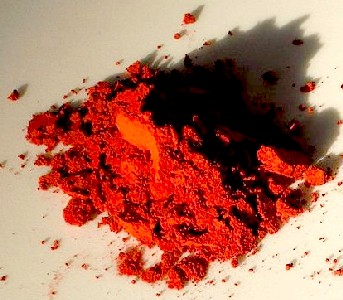
Photo: Andy Dingley - Powdered Sanguis Draconis [Dragon's Blood]
Category: Compound - Ointments
Rx: "Pulv. [powder of] Bol. ver. [Armenian Earth] Sang. Dracon. [Sanguis Draconis - dragon's blood resin] alb. Ov. [egg white] tundunt [bruised], acet. Vin. [wine vinager] Ol Ros. omph. [oleum rosarum omphacinum - Oil of Roses made with olive oil] misce ad consist. vere. [mix to true consistency]"2
Description: Moyle refers to this and Defensivum Minor as "the most powerful Defensives that are used"3. A defensive was a type of medicine applied to plasters placed on a wound to protect it from the air.4 Air was believed to have a strong effect on health and healing at this time.
Of Defensivum major in particular, Moyle says it "is commonly used in Fractures of the Limb"5.
1,2,3 John Moyle, The Sea Chirurgeon, 1693, p. 12; 4 John Quincy, Lexicon Physico-Medicum, 1726, p. 114; 5 Moyle, p. 12
Defensivum Minor
Listed in: Moyle-Composition: Defensivum Minor1
Category: Compound - Ointments
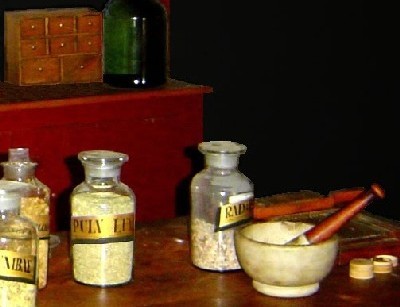
Rx: "Emplast. Diapalma [plaster of diapalma] & de minio [plaster of minio], malaxed [mixed] with Ol Ros. omph. [oleum rosarum omphacinum - Oil of Roses made with olive oil]"2
Description: Moyle refers to this and Defensivum Major as "the most powerful Defensives that are used"3. A defensive was a type of medicine applied to plasters placed on a wound to protect it from the air.4 Air was believed to have a strong effect on health and healing at this time.
Of Defensivum minor in particular, Moyle says it is commonly used "in the Luxation [dislocation of the bone] of Joints."5
1,2,3 John Moyle, The Sea Chirurgeon, 1693, p. 12; 4 John Quincy, Lexicon Physico-Medicum, 1726, p. 114; 5 Moyle, p. 12
Digestivum Optimum
Listed in: Moyle-Composition: Digestivum Optimum1
Category: Compound - Ointments
Photo: Boris Dimitrov - Cur Puppies
Rx: "Tereb. [terebinthina - turpentine] vitell. Ov. [egg yolk] Ol. Catellorum [Oil of Puppies], misce ad consistent. mellis [mix to consistency of a honey] diende adde Pulv. Croci [add powdered saffron to the mixture], q. s. {according to Art}."2
Description: Moyle calls this "the best Digestive" healing medicine.3 Digestives are "such Unguents, Balsams, or other particular Preparations, as being applied to Wounds, tend to cleanse, heal them, and promote the Discharge of a laudable Matter [meaning pus - thought to be a sign of the corrupted humors leaving the wound]."4
Moyle recommended the widespread use of this medicine on the second day after a battle to "dress all Wounds, whether incised, Pu[n]ctured, Contused, or Gunshot; where a Violent Hemorage is not expected."5 He also suggests it when dressing a compound fracture6 and when treating ulcers that can accompany an Erysipelas.7
1,2,3 John Moyle, The Sea Chirurgeon, 1693, p. 13; 4 John Quincy, Lexicon Physico-Medicum, 1726, p. 127; 5 Moyle, p. 57; 6 Moyle, p. 117; 7 Moyle, p. 138
Linamentum Arcæi
Listed in: Woodall-Chest: Linamentum Arcei1, Moyle: Linimentum arcei2, Tweedy: Linimt. Arni.3
Category: Compound - OintmentsHumoral Property: "It is of temperament hot and moist."4
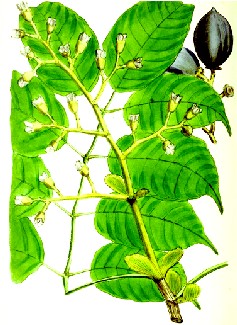
Manilla Elemi, From Medicinal Plants, Vol, 1,
By Robert Bentley & Henry Trimen, p. 60 (1880)
Rx: "Take of Gum Elemy, Turpentine of Fir tree, of each one ounce and an half; old Sheeps Sewet [suet - fat] cleansed two ounce, old Hogs grease clean-fed one ounce; mix them and make them into an Oyntment according to Art."5
Description: "I Cannot but reverence the Authour of this precious plaine Linament, whose desert to the Common-wealth was very great therein: for it is as sufficient a Balme for new wounds, especially in the head, as that a better can scarse be found out by Art. It doth all the intentions of healing a wound in the head meerely of it selfe, the flux being stayed. For it digesteth [cleanses and brings to suppuration], mundifieth [cleanses], incarneth [causes flesh to form], and siccatrizeth [cicatrizes - heals with a scar]; it defendeth from accidents, and is very anodine [soothing]: it may also fitly bee applied to painefull ulcers and fistulaes upon occasion. The Author or manifester of this Linament was Franciscus Arceus [16th century Spanish physician Francisco de Arce], in a small Treatise of Surgery of his, translated by Mr. John Reade a Surgion."6
"Although our Chirugeon [surgeon] usually use this only for Wounds and Ulcers in the Head, yet he that makes trial shall find it excellent of Ulcers if not too sanious [not discharging too much fluid], in any part of the body, tho' in the feet, & they are at the greatest distance from the head; it gently cleanseth and filleth up an Ulcer with flesh, it being of a mild nature, and friendly to the body."7
1 John Woodall, the surgions mate, 1617, p. 51; 2 John Moyle, The Sea Chirurgeon, 1693, p. 34; 3 "158. John Tweedy's Bill for Medicines. November 8, 1743". Privateering and Piracy in the Colonial Period Illustrative Documents, John Franklin Jameson, ed., p. 458; 4 Woodall, p. 51; 5 Nicholas Culpeper, Pharmacopœia Londinesis, 1720, p. 224; 6 Woodall, p. 51; 7 Culpeper, p. 224
Linmentum Compositum
Listed in: Moyle-Composition: Linmentum Compositum1
Category: Compound - Ointments

Artist: After David Teniers II - Surgeon Removing a Plaster
Rx: "Linamentum arcei {8 ounces}, Ol. Hyperic. Comp. [Oil of St. John's Wort Compound] {2 ounces}, Ol. Cera [Oil of Wax] {1/2 ounce} misce f. Balsam [mix to the consistency of a balsam]."2
Description: "...sometimes I have used this Balsamick mixture... which indeed is excellent in all Wounds, whether in Carnous [flesh] or Nervous parts, whether by Gun-shot, or Burning, or Scalding."3
This composition is really just a combination of several other compound medicines which are designed to heal wounds. Of Liniment Arcei, sea surgeon John Woodall says that it "digesteth [cleanses wounds and brings them to suppuration], mundifieth [cleanses], incarneth [causes flesh to form], and siccatrizeth [cicatrizes - heals with a scar]; it defendeth from accidents [such as infection], and is very anodine [soothing]"4. Surgeon Thomas Brugis says Oil of St. John's Wort Compound "Is an admirable balm for wounds... it is a sure medicine for all venemous wounds [and] ...it good in wounds either incised, contused, or stabbed"5. Physician Robert James says Oil of Wax is good for "discussing [dispersing] cold Tumors arising on the Face or Fingers in the Winter; and curing contracted Tendons, and the Rigidity of the Limbs thence arising ...for it has a singular Virtue in thus restoring Flexibility to the Parts"6.
1,2,3 John Moyle, The Sea Chirurgeon, 1693, p. 14; 4 John Woodall, the surgions mate, 1617, p. 51; 5 Thomas Brugis, The Marrow of Physick, 1669, p. 46; 6 Robert James, Pharmacopoeia Universalis, 1747, p. 795
Restrictiva Maxima
Listed in: Moyle: Restrictiva Maxima1
Category: Compound - Ointments
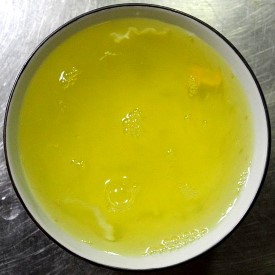
Photo: Douglas P. Perkins - Egg Whites
Rx: "Alb. Ov tund. [Egg white, beaten] acet vin. [wine vinegar] Pulv restring. major. [a compound medicine to stop bleeding] {of each as much as is sufficient} misce [mix] f. [fiat] mixtura [let a mixture be made], ad consist. vere. [to a true consistency?]."2
Description: Moyle calls this "the greatest and most used" restringent mixture.3 Restringents are styptic medicines - those used to stop bleeding.
He suggests its use during amputation after the bone[s] of a limb has been sawn through. "When it is off, apply to the end of the Bone on a thick Pledgit of dry Tow, (or if the Pledgit were sprinkled with powder of Mirrh it were better).... Then take your Buttons [pieces of tow or soft lint gathered into a button-like form], wet them in Acetum [vinegar]; (or aq. Stiptica... which is better) and arm them with your Restrictiva Maxima... (some use the dry Pulv. Restring. Major, alone) apply these to the extremities of the great Vessels and on them a Dismembring Pledgit, wet in the Acetum, and armed with the same Restrictive."4 He also suggests using it in "the Cure of a great Wound in a Musculous Part, with loss of substance" on pledgets.5
1,2,3 John Moyle, The Sea Chirurgeon, 1693, p. 11; 4 Moyle, p. 53; 5 Moyle, p. 62
Unguentum Aegyptiacum
Listed in: Woodall-Chest: Unguentum Ægyptiacum1, Moyle: Unguentum Egyptiacum2
Category: Compound - OintmentsHumoral Property: "of temperament hot and drie"3
Verdigris - Copper (II) Acetate
Rx: "Take of Verdigreese finely powdered, five parts: Honey fourteen parts; sharp Vinegar seven parts; boil them to a just thickness, & a reddish colour"4
Description: "This Unguent serveth to scower; it mundifieth [cleanses] all rotten foule ulcers, and is best to be put into the griefe scalding hot, and then the usuall paine and corrosion it procureth will be quickly past: in like manner it is to be used in any venomous wounds made either with poisoned shot, or bitten with madde dogs, or any other venomous or great contused wounds, wherein for preventing them from feare of a Gangreene it excelleth. It serveth also well to be used alone or mixed with any lotion for ulcers of the mouth and throte, especially in the scurvie. This Ung[uent]. drieth vehemently, and is abstersive [cleansing]: ...and was devised by Mesues [8th/9th Assyrian physician Yuhanna ibn Masawaih]."5
"Fabricus Hildanus [16th/17th century German surgeon William Fabry], in a Discourse concerning a Gangrene and Mortification, gives this medicine and extraordinary Recommendation, for deterging or eating off rotten Flesh, and cleansing to admiration foul Ulcers [meaning it works as a potential cautery]. This is of great use to destroy those cankerous [cancerous] Erosions which are so apt to grow in Childrens Mouths, and are first discoverable by white Specks; the way is to rub them with it upon a Rag ty'd to a Prove or piece of Stick. In Venereal Ulcerations likewise in the Throat, i.e. about the Uvula and Tonsils, it does great service."6
1 John Woodall, the surgions mate, 1617, p. 45; 2 John Moyle, The Sea Chirurgeon, 1693, p. 34; 3 Woodall, p. 45; 4 Nicholas Culpeper, Pharmacopœia Londinesis, 1720, p. 223; 5 Woodall, p. 45; 6 John Quincy, Pharmacopoeia Officinalis & Extemporanea, 1719, p. 453
Unguentum Album (White Unguent)
Listed in: Woodall-Chest: Unguentum Album1, Moyle: Unguentum Alb. Camphoratum2, Tweedy: Ungt. Alb. Camphor.3
Category: Compound - OintmentsHumoral Property: "of temperament it is cold"4
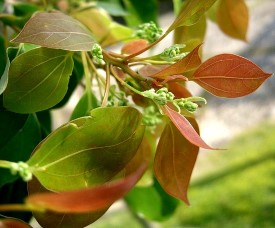
Photo: Wiki User Kenpei - Cinnamomum Camphora
Rx: "Take of Oyl of Roses nine ounce, Cerna [probably cerate - yellow wax] washed in Rose water and diligently searched, three ounces; white Wax two ounces, after the Wax is melted in the Oyl, put in the Cerus [cerate], and make it into an Oyntment according to Art; add two drams of camphire [camphor], made into powder."5
Description: "This Unguent is very good to coole, and heale any hot, moyst pustles: it cureth excoriations [abrasions] of the skinne in any place, but chiefly in the yard [penis] betwixt glans and preputium: it also healeth burnings and scaldings very well: and is good to be applied to any painefull ulcer, for it asswageth paine and healeth well. It was invented by Avicene [Avicenna - 10th century Persian physician]: [it is]... anodine [soothing], mollificative [softening], and attractive, and therefore of very good consequent in the Surgeons chest."6
1 John Woodall, the surgions mate, 1617, p. 45; 2 John Moyle, The Sea Chirurgeon, 1693, p. 34; 3 "158. John Tweedy's Bill for Medicines. November 8, 1743". Privateering and Piracy in the Colonial Period Illustrative Documents, John Franklin Jameson, ed., p. 458; 4 Woodall, p. 45; 5 Nicholas Culpeper, Pharmacopœia Londinesis, 1720, p. 223; 6 Woodall, p. 45
Unguentum Apostolorum [Unguent of the Apostles]
Listed in: Woodall-Chest: Unguentum Apostolorum1, Moyle: Unguentum Apostolorum2
Category: Compound - Ointments
Humoral Property: "it is of temperament hot and drie"3
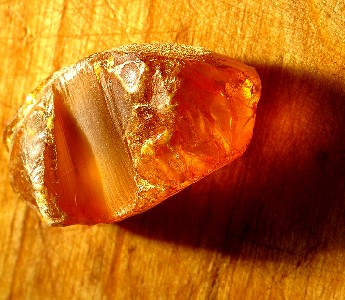
Photo - Flickr User Keansu - Rosin
Rx: "Take of Turpentine, yellow Wax, Rosin [Greek Pitch], Ammoniacum, of each four drams; long Birthwort roots, Olibanum [Frankincense], and Bdellium, of each six drams; Mirrh, Galbanum, of each half an ounce; Opopanax, Verdigreese, of each two drams; Litharge [Lead Oxide] 9 drams, [olive?] Oil 2 pound, Vinegar enough to dissolve the Gums, make it into an Oyntment according to Art."4
Description: "This unguentum serveth well to clense and scower ulcers, and fistulaes, and to take a good ground to healing: ...it was devised by Avicene [Avicenna - 10th century Persian physician], named Apostolorum, for that it consisteth of 12. simples, joyned into one body."5
"It consumes corrupt and dead flesh [meaning it works as a potential cautery], and makes flesh soft which is hard; it cleanseth Wounds, Ulcers and Fistulaes, and restores flesh where it is wanting."6
1 John Woodall, the surgions mate, 1617, p. 44; 2 John Moyle, The Sea Chirurgeon, 1693, p. 34; 3 Woodall, p. 44; 5 Nicholas Culpeper, Pharmacopœia Londinesis, 1720, p. 231; 5 Woodall, p. 44; 6 Culpeper, p. 231
Unguentum Aragon
Listed in: Woodall-Chest: Unguentum Aragon1
Category: Compound - Ointments
Humoral Property: hot2

Photo: Ken Thomas
Roots of Aron - Trillium Erectum
Rx: "Take of Rosmary, Marjoram, Mother of Time [Thymus serpyllum], Rue, the Roots of Aron and Cucumers, of each four ounces and an half; the leaves of Bay, Sage, Savin [juniper], Briony roots, of each three ounces; Fleabane, Laurel [Bay], of each nine ounces; the leaves of wild Cucumers, Nep [Catnip], of each half a pound. Let all of them be gathered in May, cleansed and bruised, be steeped seven days in the six pound of Sallet [Olive] Oyl, and a pound of Spirit of Wine, boyl them gently till the spirit be consumed, then strain the Oyl, in which melt Wax 16 ounces, Bears grease, Oyl of Bays, of each 3 ounces, Moschaleum [probably Oil of Moschelini] half an ounce, Butter 4 ounces, stir them and put in these following things in powder, Mastich, Olibanum [Frankincense] of each seven drams, Pellitory of Spain, Euphorbium, Ginger, Pepper of each an ounce; make 'em into an Oyntment according to Art."3
Description: "This Unguent is numbred among the 4 hot Unguents. It profiteth generally against all cold effects of the outward parts of the body: it much warmeth and comforteth the sinews: it is good against convulsions & cramps: it is good to anoint the Ridge bone of the backe, and the parts neere the kidneys against the paines thereof: and also to anoint the stomacke & belly upon any cold griefe: it is good to annoint the body for them which have the quartane fever [malarial fever, recurring every three days], the falling sicknes [epilepsy], the paines of the joynts: and also it is good to be used as a Morbus ointment [ointment to treat syphilis], according to the common phrase, adding the due quantitie of Mercurie thereto, which I account to be of Quick-silver {2 ounces} to the Unguent {1 pound}. But I finde it will not retaine his vertues above one yeare, as witnesseth [16th century Swiss physician] Johannes Jacobus Wikerus. Wherefore I forbeare this composition [the Morbis ointment] in the Surgions Chest."4
1,2 John Woodall, the surgions mate, 1617, p. 51; 3 Nicholas Culpeper, Pharmacopœia Londinesis, 1720, p. 221; 7 Woodall, p. 51-2
Unguentum Aureum
Listed in: Woodall-Chest: Unguentum Aureum1
Category: Compound - Ointments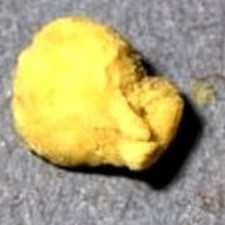
Yellow Wax
Rx: "Take of yellow Wax half a pound, common [Olive] Oil two pound, Turpentine two ounce, Pine Rosin, Colophonia [also pine rosin], of each one ounce and an half; Frankinzense, Mastich, of each one ounce; Saffron one dram, first melt the Wax in the Oyl, then the Turpentine being added, let them boyl together; having done boyling, put in the rest in fine powder (let the Saffron be the last) and by diligent stirring, make them unto an Oyntment according to Art."2
Description: "This Ung[uent]. serveth well to incarne [cause flesh to form in] wounds and ulcers, being first well mundified [cleansed]: it is also to bee used as a balme to them to heale them, and is a good healer of burnings & scaldings, the fire first taken out: The composition which I doe make is of the practice of Josephus Quercitanus [16th century French physican Joseph Duchesne] whose good use I have made triall of, which I meane with the rest of the composition to publish in print."3
"This is a Composition originally of Mesue [8th/9th Assyrian physician Yuhanna ibn Masawaih], and had this Name first given it both on account of its Colour, and the wonderful Virtues ascribed to it, on which last Score too by some Authors it is title Unguentum Regis. ...Yet I cannot learn that it is in any great Esteem in the present Practice of our Surgeons; tho [Johann] Zwelfer [16th century German physician and apothecary] says it is a wonderful good Incarner, especially in the most tender Constitutions: But he says that it is much better for several Purposes, especially in Wounds of the Head, and Tendons, to use in it Oil of Turpentine instead of the common Oil."4
1 John Woodall, the surgions mate, 1617, p. 44; 5 Nicholas Culpeper, Pharmacopœia Londinesis, 1720, p. 224; 3 Woodall, p. 44-5; 4 John Quincy, Pharmacopoeia Officinalis & Extemporanea, 1722, p. 500
Unguentum Basilicon
Listed in: Woodall-Chest: Unguentum Basillicum1, Moyle: Unguentum Basilicon. Major2
Category: Compound - OintmentsHumoral Property: "of temperament warme"3
Photo: Mattes
Rx: "Take white Wax, Pine Rosin, Heifers Sewet [beef fat], Greek Pitch [rosin], Turpentine, Olibanum [Frankincense], Myrrh, of each an ounce, Oyl five ounces; Powder the Olibanum and Myrrh, and the rest being melted, make it into an Oyntment according to Art."4
Description: "This Unguent doth digest [cause the growth of healthy flesh] and incarne [grow flesh in] wounds and ulcers, and will also prepare and bring to superation [cause to form pus] an Aposteme either hot or cold, being somewhat thicke spread on towe [lint], or le[a]ther and applied thereto: it also mittigateth the paine and pulsation thereof, and is likewise very fitly mixed either with precipitate [Mercury Precipitate] or Unguentum Ægyptiacum, or the like medicine, the more easier and better to mundifie [cleanse] and clense an ulcer: This unguent ... is ascribed to have beene devised by Gallen, it is also good for burnings, and scaldings."5
"This is now much in use in Chirurgery [surgery] for a Digestive, but it is sometimes apt to incarn too fast, and therefore wants a little Precipitate [of Mercury] to be mix'd with it: tho this is not so generlaly in practice as formerly"6.
1 John Woodall, the surgions mate, 1617, p. 44; 2 John Moyle, The Sea Chirurgeon, 1693, p. 34; 3 Woodall, p. 44; 5 Nicholas Culpeper, Pharmacopœia Londinesis, 1720, p. 224; 5 Woodall, p. 44; 6 John Quincy, Pharmacopoeia Officinalis & Extemporanea, 1719, p. 454
Unguentum Contra Ignem (Burn Ointment)
Listed in: Woodall-Chest: Unguentum contra ignem1
Category: Compound - Ointments
Powdered White Sulfur
Rx: 'Unguentum Contra Ignem' is Latin for "unguent for burns". Woodall refers his readers to alchemist Johannes Jacob Wecker as the source of this recipe, most likely from his book Le Grand Thesor ou Dispensaire et Antidotaire.
There is a burn ointment in the 1616 printing which I have translated from the original French and Latin: "The Unguent for remedying burns. Rx. Rose Oil {8 ounces}, oil of egg yolks {2 ounces} powdered white sulphur {1 ounce}, middle bark of elder {1 handful}, white wax {1/2 ounce}, heat all together into an unguent."2
Description: "This composition used to that purpose, you shall finde in Johannes Wikerus his dispensatory, pag. 1174. I have found it very good against burnings and scaldings; as also against burnings with gun-powder. Where I write the compositions of my medicines in generall, that also shall be expressed."3
1 John Woodall, the surgions mate, 1617, p. 48; 2 Johannes Jacob Wecker, Le Grand Thesor ou Dispensaire et Antidotaire, 1616, [Translated from Old French], p. 1067; 3 Woodall, p. 48
Unguentum Contra Scorbutum (Scurvy Ointment)
Listed in: Woodall-Chest: Unguentum contra scorbutum1
Category: Compound - Ointments

What a Ship Full of Scurvied Men Might Look Like,
From Gustav Dore's Rime of the Ancient Mariner (1876)
Rx: 'Unguentum Contra Scorbutum' is Latin for "unguent for scurvy". Although Woodall promises (twice) to recite the composition for his version of this, he never formally spells it out as such in his book. Seventeenth century German physician Michael Ettmüller does give a recipe for such an unguent, which is translated below out of the original Latin.
"Pulv rad. Bistort. [bistort root], Fl Balaust [dried pomegranate flower], Ros. Arbor. [rose wood] {of each 3 scruples}, Myrrhæ el [myrrh], Aluminis ust. [burnt alum] an. {1 scruple} to {half scruple} of each, Mell. rosat. [honey of roses], as much as is necessary. heat honey over a fire, sprinkling in powders, make into an electuary."2
Description: "I have had the practise thereof and found it very good to attenuate grosse tumors of the Scurvy, to asswage the paines of them, and by the use thereof to dissolve such tumors. I use this Unguent in cold causes, in want whereof ung: Martiatum, or Oleum Laurini [Oil of Bays] or [Unguent] Dialthea: but in hot griefes and very painefull I use [Unguent] Populeon."3
1 John Woodall, the surgions mate, 1617, p. 48; 2 Michaelis Ettmuller, "Phil. Et Med. D. Dissertationes Academæ" Opera Omnia, [Translated from Latin], p. 156 (780 if not repaginated); 3 Woodall, p. 48
Unguentum de Mercurio (Mercury Ointment)
Listed in: Woodall: Unguentum de Mercurio1
Category: Compound - Ointments

Rx: "You may make this [from] Unguent of Dialthea, oleum Laurini [Oil of Bays]. {of each 1/2 pound}. Mercurius vivus. Or quicke silver {2 ounces} oleum spice [Oil of Spike] or Tereb. [Oil of Turpentine] If you have them {of each 1/2 ounce} & if you see cause in very cold bodies you may adde of Euphorbium in powder {2 drams}.
...
I wish not the Surgeon to carry any of this Unguent ready made to the East Indies: for the Quicksilver [mercury], it is to be feared, will fall to the bottom; but if he will needes have it ready made, let him adde to the composition, wax a sufficient quantitie, but it must be made, as followeth. Your wax and unguent must bee melted together, which being yet warm Rx Terebinthine clare [clarified turpentine] {1 ounce} being put into the bottom of a wooden bowle, or brasse bason; and stirring it so long till all the Quicke-silver be cleane lost and turned into a blew [blue] salve no more to bee seene; then by little and little mixe it with the former, and being almost coagulated, I meane almost cleane cold, neither liquid through heate, nor altogether cold, and worke the Terebinthine with the Mercury altogether strongly till it bee cold."7
Description: "This Unguent is good to provoke a flux [flow - this could be either salivation, vomiting or diarrhea]....
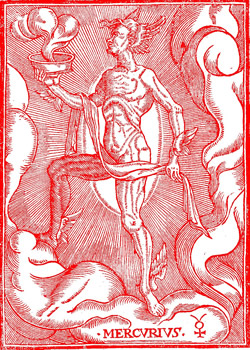
"In Praise of Mercury", From The surgions
mate, by John Woodall, p. 297 (1617)
You must use it cold, and either let the Patient stand afore the fire & chase it in. But note, he which anointeth others therewith if he use it too often, let him put a bladder on his hands [to protect them], for the often use thereof causeth many evils. The Unguent hath as many vertues as vices, and as many vices as vertues, a whole weeke may be easily spent with good profit to the Ready in writing of Mercurie, I hartily with some learned and worthy man would take it in hand truely to anatomize the subject: I am perswaded, yea and know well, he might therby save the lives of many an innocent foule [fool], who with great infamie perish through the inordinate use of this Unguent, and yet the medicine is good: but I referre the Surgions Mate for the use of this Unguent to read Mr. [English surgeon William] Clowes his booke of Surgery.
But concerning the ordinary uses thereof, if you anoint the joynts therewith it killeth the itch but if you anoint too plentifully it provoketh a flux, sometimes upward, sometimes downeward. If you anoint the seames of his shirt which is lowsie [lousy - filled with lice] therewith, it driveth away all the lices the same it doth to the lice of the eye browes and secret parts, therewith many are troubled. Also for the Piles [hemorrhoids] it is a very good medicine; I use it in that case first to purge the Patient, and after to anoint him with Unguentú[m] Album wherein quick-silver is mixed, namely of the Unguentum {1 ounce} of Mercurie {1 dram} misce [mixed], and anoint therewith daily three times and keep the place very warme."3
1 John Woodall, the surgions mate, 1617, p. 49; 2 Woodall, p. 49-50; 3 Woodall, p. 50-1
Unguentum de Mucilaginibus (Mucilage Unguent)
Listed in: Moyle: Unguentum de Mussilaginibus1
Category: Compound - Ointments
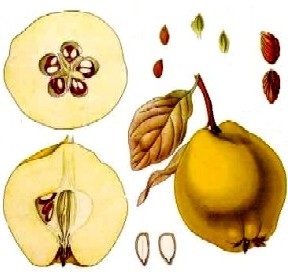
Quince and Seeds, From Franz Eugen
Kohler's Medizinal-Pflanzen (1897)
Rx: "Take of the Oils of White Lillies, Orrice [iris], Violets, and Chamomile, {of each 6 ounces} of the Mucilage [made] of Linseed, Quinceseed, Fenugreek Seeds, and Marsh-mallow Roots, {of each 4 ounces} of Ducks and Hens Fat, {of each 5 ounces} of white Wax {1 pound} mix and make into an Ointment, S. A. [according to art]."2
Description: Of Unguentum de Althæa, physician Jean de Renou noted that it warms, softens and reduces the force of 'bad' humors, moistens and promotes the growth of healthy flesh.3
John Moyle is the only sea surgeon author in our study who includes both this unguent and Unguentum de Althæa, even though apothecary John Quincy says "it differs not much from the Unguentum de Althæa [Dialthæa], and is certainly continued for the same Intention; yet we meet with it but little, if at all in the common Practice."4 Presumably Moyle either saw the need for two similar wound healing unguents or noticed subtle differences between the three medicine's operations.
1 John Moyle, The Sea Chirurgeon, 1693, p. 34; 2 John Quincy, Pharmacopoeia Officinalis & Extemporanea, 1722, p. 509; 3 Jean de Renou, A Medicinal Dispensatory, 1657, p. 698; 4 Quincy, p. 509
Unguentum Dialthaea (Ointment of Marshmallows)
Listed in: Woodall-Chest: Dialthea simplex1, Moyle: Unguent. De Althæa2, Tweedy: Ungt. Dialth.3
Category: Compound - Ointments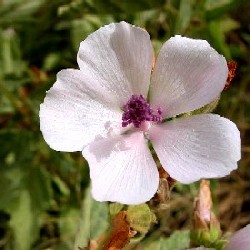
Photo: Pablo Alberto Salguero Quiles
Marshmallow Flower
Rx: "Take the Oil of Mucilages, two Pounds, of yellow Wax, half a Pound; of white Rosin, three Ounces; and of Venice Turpentine, an Ounce and half; mix them together and make an OIntment according to Art."4
Description: "This has the properties of the former [Unguentum Dialthaea Compositum], but the former is better."5
Of Unguentum Dialthaea Compositum, Woodall says, "It is profitable against paines of the breast proceeding of a cold cause, and against the Plurisie: it warmeth, mollifieth [softens], and comforteth all the parts of the body which are evill disposed through cold infirmities. It is also good against stiffenes & paines of the joynts in the Scurvy."6
"This is much us'd as an Emollient [softening medicine] and Relaxer."7
1 John Woodall, the surgions mate, 1617, p. 49; 2 John Moyle, The Sea Chirurgeon, 1693, p. 34; 3 "158. John Tweedy's Bill for Medicines. November 8, 1743". Privateering and Piracy in the Colonial Period Illustrative Documents, John Franklin Jameson, ed., p. 458; 4 Robert James, Pharmacopoeia Universalis, 1747, p. 748; 5 Woodall, p. 49; 6 Woodall, p. 48-9; 7 James, p. 748
Unguentum Dialthaea Compositum (Unguent Nicolaus)
Listed in: Woodall-Chest: Unguentum Dialthea compositum1
Category: Compound - OintmentsHumoral Property: warm [califies] and moist [humectates]2; heats and moistens3

Photo: Pablo Alberto Salguero Quiles
Marshmallow Flower
Rx: "Take of Marshmallow roots [Althea Officinalis] a pound, the seeds of Flax and Fenugreek, of each one pound; pulp of Squills half a pound, Oyl four pound, Wax one pound; Turpentine, Gum of Ivy, Galbanum of each two ounces; Colophonia, Rozin, of each half a pound; let the roots be well washed and bruised, as also the Linseed, Fenugreek seeds and Squills, then steep them three days in eight pints of Water, the fourth day boil them a little upon the fire, and draw out the Mucilage, of which take two pound, and boil it with the Oyl to the consumption of the juyce; afterwards add the wax, Rozin and Colphonia, when they are melted, add the Turpentine, afterwards the Galbanum and Gum of Ivy dissolved in Vinegar; boyl them a little, and having removed them from the fire, stir them till they are cold, that so they may be well incorporated."4
Description: "This Unguent Nicolaus an ancient writer seemeth to be the Author of. [He is referring to Nicolas de Salerno's Antidotarium.] It is profitable against paines of the breast proceeding of a cold cause, and against the Plurisie: it warmeth, mollifieth [softens], and comforteth all the parts of the body which are evill disposed through cold infirmities. It is also good against stiffenes & paines of the joynts in the Scurvy."5
NIcholas Culpeper calls this Oyntment of Marshmallows compound Nich, which is short of Nicolas, agreeing with Woodall. He says that it "helps pains of the Breasts coming of cold, and Pleurisies, old Aches and Stiches, and softens hard swellings."6
1,2 John Woodall, the surgions mate, 1617, p. 48; 3,4 Nicholas Culpeper, Pharmacopœia Londinesis, 1720, p. 223; 5 Woodall, p. 48-9; 6 Culpeper, p. 223
Unguentum Diapompholigos
Listed in: Woodall-Chest: Unguentum Diapompholigos1, Moyle: Unguentum Diapompholigos2
Category: Compound - Ointments
Humoral Property: "of temperament it is cold and dry"3
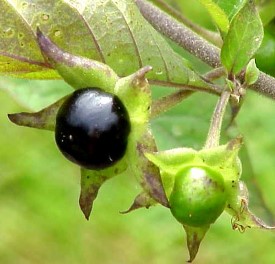
Photo: Kurt Stuber
Deadly Nightshade - Atropa Bella-donna
Rx: "Take of oil of Nightshade sixteen ounces, white wax washed, Cerus [possibly cereus - yellow wax] of each four ounces: Lead burnt and washed, Pompholix [zinc oxide] pre[ci]pated of each two ounces, pure Frankincense one ounce, bring 'em into the form of an Oyntment according to Art."4
Description: "This unguent is good to heale painefull ulcers in any part of the body, especially of the yard [penis], or betwixt glans and preputium, as also any fretting or painefull ulcers of the leggs, or elsewhere. I have found it before all other Unguents in ulcers of the yard, against virulent, painfull, and corrosive ulcers scarse a better composition is knowne; in Nolime tangere [A cancerous ulcer that eats away bone and soft tissue] in the face I have had good experience of it: and in many other occasions I have found it a very good Unguent... Nicolaus Alexandrinus [13th century Byzantine physician Nicholas Myrepsos] was the Author of it."5
1 John Woodall, the surgions mate, 1617, p. 45; 2 John Moyle, The Sea Chirurgeon, 1693, p. 34; 3 Woodall, p. 46; 4 Nicholas Culpeper, Pharmacopœia Londinesis, 1720, p. 225; 5 Woodall, p. 45-6
Unguentum Martiatum (Soldier's Ointment)
Listed in: Woodall-Chest: Unguentum Martiatum1, Moyle: Unguentum Martiatum2
Category: Compound - Ointments
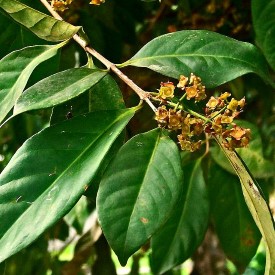
Photo:W. A. Djatmiko - Bay Leaves
Rx: "Take of fresh Bay leaves three pound Garden Rue 2 pound and an half, Marjoram two pounds Mints a pound, Sage, Wormwood, Costmary [Tanacetum balsamita], Bazil [Basil] of each half a pound, Sallet [Olive] oyl 20 pound[,] yellow Wax four pound, Malaga wine two pound, of all of them being bruised, boiled, and pressed out as they ought, make an Oyntment according to Art."3
Description: "This Unguent, as is composed of many ingrediences, so it is said to be effectuall for many greefes: for saith the Author [13th century Byzantine physician Nicholas Myrepsos4], it discusseth [disperses] cold causes in the head sinewes, and joynts: it removeth the paine from the breast and stomacke proceeding from cold: it prevaileth against convulsions: it helpeth the resolution of the sinewes, dead palsey [Parkinson's disease], and them that are troubled with the Sciatica, or hip gout, the gout in the hands, feete, and in other joynts of the body. It mollifieth [softens] hard pustles and tumors in the flesh: it asswageth the hard swellings of the Liver and spleen: easeth the paine in the small gutts: it cureth the ach in the reyns [loins]."5
1 John Woodall, the surgions mate, 1617, p. 52; 2 John Moyle, The Sea Chirurgeon, 1693, p. 34; 5 Nicholas Culpeper, Pharmacopœia Londinesis, 1720, p. 223; 4 See Johannes Jacob Wecker, Le Grand Thesor ou Dispensaire et Antidotaire, 1616, [Translated from Old French by the author], p. 1021; 5 Woodall, p. 52
Unguentum Nervinum (Nerve Ointment)
Listed in: Moyle: Unguentum Nervinum1
Category: Compound - Ointments

Photo: Wiki User BerndH - Cowslips (Primula Veris)
Rx: "Take of Cowslips [Primula veris] with the Flowers, Sage, Chamepitys [Ajuga chamaepitys], Rosemary, Lavender, Bay with the Berries, Chamomel, Rue, Smallage [Wild celery], Melilot with the flowers, Wormwood of each a handful; Mints, Betony, Penyroyal, Parsly, Centaury the less, St. Johns wort of each half a handful; Oyl of Sheeps or Bullocks suet or the Marrow of either two pound; the Herbs being bruised and boyled with the Oyl and Suet, make it into an Oyntment according to Art."2
Description: "Cures cold Diseases of the nerves, and all other parts of the Body; anoint the Sutures [of the skull], nape of the Neck, and back Bone, the stomach and soles of the Feet likewise"3.
"It is appropriated to the Nerves, and helps their infirmities coming of cold (which you may find often enough related. I do not have always to harp upon the same string) as also all old bruises; make use of it in dead Palsies [Parkinson's disease], chilness or coldness of particular members, such as the Arteries perform not their office to as they ought; for wind, annoint your Belly with it; for want of Digestion your Stomach for the Cholick, your Belly for whatsoever Disease in any part of the Body comes of Cold, esteem of this as a Jewel; and you shall give me thanks for declaring it, after you have been thankful to God for raising me up to that end."4
1 John Moyle, The Sea Chirurgeon, 1693, p. 34; 2 Nicholas Culpeper, Pharmacopœia Londinesis, 1720, p. 233; 3 Thomas Brugis, The Marrow of Physick, 1669, p. 34; 4 Culpeper, p. 233-4
Unguentum Nutritum seu Tripharmicum
Listed in: Woodall-Chest: Unguentum Tripharmacon, or Nutritum1
Category: Compound - Ointments
Humoral Property: "of temperament this Unguent is cold and dry"2

Litharge of Gold - Lead (II) Suboxide
Rx: "Take of Litharge of Gold, finely powdered half a pound, Vinegar one pound, Oyl of Roses two pound: grind the Litharge in a Mortar, pour into it sometimes Oyl, sometimes Vinegar, till by continual stirring the Vinegar do no more appear, and it comes to a whitish Oyntment."3
Description: "This serveth well to cure an Erysipilas [skin infection with a rash - St. Anthony's Fire], excoriation [abrasions], or bladderings of the skin: such also as are termed the Shingles: it is also good for to take the fire out of burnings and scaldings: and for any moist humour flowing to any ulcers in any part of the body being spread upon cap paper [cap paper is coarse brown paper like wrapping paper4] thin, and laid over the whole distempered part: and against any sleight scabbiness or itching humour whence soever it is: also an especiall good defensative against any scalding or vitious [vicious] humour flowing to any ulcer... It is subject to divide it selfe, namely the oyle Litharge & vineger asunder, which if it be wrought together againe will be as good as at the first: and if it be over dry adde vineger and oyle thereto, an it will be as good as at first."5
1,2 John Woodall, the surgions mate, 1617, p. 46; 3 Nicholas Culpeper, Pharmacopœia Londinesis, 1720, p. 227; 4 Samuel Johnson, "Cap-Paper", A dictionary of the English language, 3rd ed., 1768, not paginated; 5 Woodall, p. 46-7
Unguentum Pectorale (Pectoral Ointment)
Listed in: Woodall-Chest: Unguentum Pectorale1
Category: Compound - Ointments
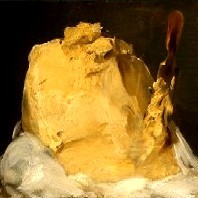
Artist: Antoine Vollon
Butter (late 19th c.)
Rx: "Take of fresh Butter washed in Violet water six ounces; Oyl of sweet Almonds four ounces; Oyl of Camomel and Violets, white Wax, of each three ounces Hen & Ducks grease, of each two ounces; Orris [iris] roots two drams Saffron half a dram. The two last being finely powdered, the rest melted & often washed in Barley or Hysop water, make an Oyntment of them according to Art."2
Description: "It [as]swageth the paines and stitches of the breast and sides; easeth the cough, helpeth expectoration [spitting and coughing up of phlegm]: it helpeth to digest grosse humours, and to attenuate them: and warmeth and comforteth a cold stomacke. This composition is set downe in the dispensatory of Augusta."3
"This is commended to anoint the Breast with, in all Diseases of that Part, as it is suppos'd to open and relax the Vessels, and give more room for their respective Fluids to move in: for which reason it is judg'd of service in Pleurisies, Asthma's, and such like Ailments. But the present Practice has always recourse to extemporaneous Forms in such Cases, and very rarely takes notice of this. This Medicine likewise will not keep long without turning rancid, and therefore ought to be made but in small quantities by those who have Opinion enough to continue its use."4
It is odd that Woodall would chose to put a medicine that went rancid quickly in his medicine chest.
1 John Woodall, the surgions mate, 1617, p. 46; 2 Nicholas Culpeper, Pharmacopœia Londinesis, 1720, p. 234; 3 Woodall, p. 46; 4 John Quincy, Pharmacopoeia Officinalis & Extemporanea, 1719, p. 458
Unguentum Populeon (Poplar Ointment)
Listed in: Woodall-Chest: Unguentum Populeon1, Moyle: Unguentum Populion2
Category: Compound - OintmentsHumoral Property: "Of temperament it is cold & moist"3
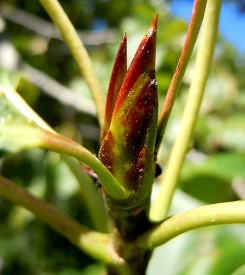
Photo: Matt Lavin
Poplar Bud - Populus Balsamifera
Rx: "Take of fresh Poplar buds 1 pound & an half the flowers of Violets, & Navilwart of the wali [Umbilicus rupestris], of each 3 ounces fresh Hogs grease 3 pound all of them being beaten together in May. Let them stand a while, add the tops of Rasberries, the leaves of black Popies, Mandrakes, Henbane, Nightshade, Lettuce, Housleek, great & small Burrs of the greater of each. 3 ounces; beat them all together, & all of them being mixed, after ten days with a pound of Rosewater, boyle it till all the superfluous humidity be consumed, then strain it, and press it out that it may be an Oyntment according to Art."4
Description: "This serveth well to asswage the paines of the Scurvy by anointing the parts greeved therewith. I may justly say upon the experience of divers skilfull Surgions, and my owne also, that as well in hot as in cold Countries it hath been found exceeding comfortable and behovefull, that scarse any composition of an Unguent in the Surgions Chest may compare with it, which some may thinke is a very absurd affirmation in reason, but that experience will have it so. It is good also to anoint the Temples, to provoke rest in hot fevers: as also the palmes of the hands and soles of the feet. It is likewise good to be applied for [as]swaging of paine in any part of the body, and being applied cold upon a Plegent [plegit - piece of cloth] where you have laid any corrosive medicine [potential cautery]; it easeth the dolour [grief] of the causticke medicine [potential cauteries]. ...it was devised by Nicolaus [13th century Byzantine physician Nicholas Myrepsos]."5
1 John Woodall, the surgions mate, 1617, p. 47; 2 John Moyle, The Sea Chirurgeon, 1693, p. 34; 3 Woodall, p. 47; 4 Nicholas Culpeper, Pharmacopœia Londinesis, 1720, p. 234; 5 Woodall, p. 47
Unguentum Potabile [Drinkable Ointment1]
Listed in: Woodall-Chest: Unguentum potabile2
Category: Compound - Ointments
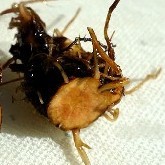
Photo: Wolfgang Frisch
Tormentil Root
Rx: "Take of Batter without salt a pound and an half, Spermæ Cæti [spermaceti], Maddir [Rubia plant], Tormentil roots, Castoloreum, of each half an ounce. Boyl them as you ought, in a sufficient quantity of Wine, till the Wine be consumed, & become an Oyntment."3
Description: "This Unguent is a sure Balsame for wounds of any sort, or in any part of the body, either penetrating or not penetrating; in wounds penetrating either inject it warme, or power it into the wound [with a syringe]. Also upon any occasion it is to be drunke {1 or 2 drams} at once, or for a dose. It healeth wounds within the body. Also it healeth burnings and scaldings without any scarre. And further it cureth the winde chollicke drunke with sacke [White wines imported from Spain and the Canaries]: the dose is to be {1 ounce} without feare: but I give usually but one dramme or {2 drams}."4
In his description, Nicholas Culpeper simply says, "I know not what to make of it."5
1 Joan Druett, Rough Medicine, 2001, Appendix A; 2 John Woodall, the surgions mate, 1617, p. 49; 3 Nicholas Culpeper, Pharmacopœia Londinesis, 1720, p. 227-8; 4 Woodall, p. 49; 5 Culpeper, p. 228
Unguentum Rosatum (Rose Ointment)
Listed in: Woodall: Unguentum Rosatum1
Category: Compound - Ointments
Humoral Property: "of a fine cooling Nature"2

Photo: Yellow Cat - Red Roses
Rx: "Take of Hogs grease well cleansed from the skin a pound, wash it nine times. (Be sure you miss not one of them) in warm water, then as often in cold water, fresh red Roses a pound; mix them together, and so let them stand seven days; then boyl them over a gentle fire, and strain out the Roses, then mix with the Oyntments the like quantity of fresh red Roses, and then let them stand together as many days; then strain them out, having first boyled them; at last add juice of red Roses 6 ounces, boil them over a gentle fire till the juice be consumed; then strain it and make an Oytment according to Art."3
Description: "This is used against inflammations, and Ignis sacer [St. Anthony's fire - skin infection with rash], and all hot paines of the head: it asswageth the paines of the Liver, kidneies, and belly proceeding of heate, and hath vertue to corroborate. It was invented by Mesues[8th/9th Assyrian physician Yuhanna ibn Masawaih]."4
It is ...exceeding useful in all gaulings of the Skin and fretting [corrosion] accompanied with cholerick humours [yellow bile, one of the bodily humors], angry Pushes [pimples], Tetters, Ring worms. It mitigates Diseases in the Head coming of heat; as also the intemperate heat of the Stomach and Liver."5
1 John Woodall, the surgions mate, 1617, p. 46; 2,3 Nicholas Culpeper, Pharmacopœia Londinesis, 1720, p. 228; 4 Woodall, p. 46; 5 Culpeper, p. 228

